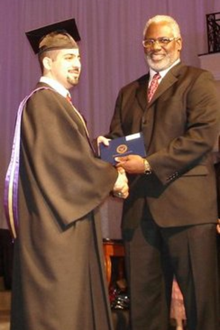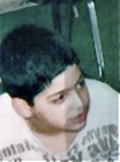 |
| Afif graduated from college in 2011. |
It is the middle of the year for my fourth grade class at Abqaiq School in Saudia Arabia. The class consists of only 11 students, one of which is my daughter Marie. The students hail from various ethnic backgrounds: American, Canadian, Jordanian, Lebanese, and Pilipino, etc. Afif, a Lebanese boy, has some type of a syndrome and so far no one is able to tell us exactly what it is. All we know is that he is severely learning disabled with an IQ of about 75.
Afif is very social, I believe the term medical professionals use is “cocktail personality.” The other students really like him, but the school administration isn’t sure what to do because they know that as the years progress, he will fall further and further behind. His mother and father are at their wits’ end. They know Afif will most likely have to go back to Lebanon for a special program. The problem is that in Lebanon, special schooling for someone like Afif means possibly being sequestered away in a facility built for warehousing rather than educating. It’s basically a holding tank for people they have deemed uneducable. His mother is becoming frantic. Teachers in the upper grades are concerned, to say the least. What if they get Afif? What are they going to do with him?
All I know to do with Afif is to keep plugging away with the basics. I set him up with lots of partner reading. I work with him on letter recognition and phonemic awareness activities. Afif enjoys listening to stories.
He likes to talk about the pictures. Still, in fourth grade, he can’t read a lick.
He has other talents, though. In math one day, I hold up a number chart with numbers from one to 100. As I am going over the chart with him, I notice he has a very good understanding of number order. As I am looking at the chart with the blank back facing him, he touches a spot—without being able to see through it—on the back of the chart and says “81!” I flip the chart over to see where he is pointing and damned if he isn’t touching the correct spot. The amazing thing is he is looking at the chart in reverse order. I began to quiz him with my eyes on the front and his on the blank side.
 |
Young Afif when he was
Kevin Baxter's student. |
“Afif, where’s 21?”
“Here!”
“Correct! 75?”
“Here!”
Afif finds the numbers on the chart without seeing it and whether it is upside down, or backwards. Amazing, I think, just like Dustin Hoffman in the movie Rainman. His understanding of the chart does not translate to other areas in math, though. He can only do rudimentary addition and his other math skills are negligible.
At the moment though, we are focusing on books. Holding up a book about African animals I ask, “Afif, what are these pictures showing?” Sitting directly across the table from me, Afif picks up a book quite unannounced and suddenly, inexplicably, begins to read. I look up from the book I’m holding and my jaw drops.
“Afif—you’re reading!” He looks up at me and says with a sly grin, “I know.”
His reading is stiff. He is pronouncing the words of his book very carefully. However, he is, without a doubt, reading. I say again, “Afif, you’re reading!”
He continues smiling as he reads away. To make sure he hasn’t just memorized something he heard before, I find another book on the same level and hand it to Afif. “Here’s a funny book, Afif. Will you read it to me?” Afif accepts the book, looks over the cover carefully, and opens it to the first page. Then he begins to read.
Feeling I need to document the moment, I tell Afif to keep reading to himself as I stand up and walk across the hall to my colleague teaching the other third grade class.
I grab her by the shirtsleeve and drag her to my room. She looks at me as if I’m insane.
I say, “Listen to this.” As Afif continues to read, tears fill her eyes, because she knows what this means. The fact he can read now means Afif will be staying with us, because if he can read, he can learn other things as well. The school will be able to accommodate him.
Now I am curious as to what may have caused, seemingly from out of nowhere, Afif’s sudden ability to decode words. Sometimes reading is like cracking a safe—when the tumblers align, a world of possibility opens. I don’t know what “tumblers” I helped Afif align, I just kept trying different combinations. I do know I am always curious about how children use language, and that curiosity has driven me to learn as much as I can about the process of language development. I try to apply that knowledge in my classroom. The best advice I ever received about teaching reading, whether phonics, phonemics, or whole language, was: use whatever works.
In Afif’s case maybe he was just ready to read. Probably the constant exposure to sounds, letters, words, rhymes, and pictures he received over the years kicked in and it all began to make sense to him. The tumblers simply fell into place. A connection was made. Whatever it was, I felt blessed to witness it. These moments are why I continue to teach.
 Kevin Baxter holds a master's degree in early childhood education, a bachelor's degree in elementary education and is a certified teacher of the gifted. He has taught pre-school though fifth grade and has also taught master's level courses on reading disabilities at the University of San Diego. He spent 12 years teaching in Saudi Arabia and conducted teaching workshops in various countries around the world. He currently resides in Asheville, NC, and was a Buncombe County Schools Teacher of the Year.
Kevin Baxter holds a master's degree in early childhood education, a bachelor's degree in elementary education and is a certified teacher of the gifted. He has taught pre-school though fifth grade and has also taught master's level courses on reading disabilities at the University of San Diego. He spent 12 years teaching in Saudi Arabia and conducted teaching workshops in various countries around the world. He currently resides in Asheville, NC, and was a Buncombe County Schools Teacher of the Year.